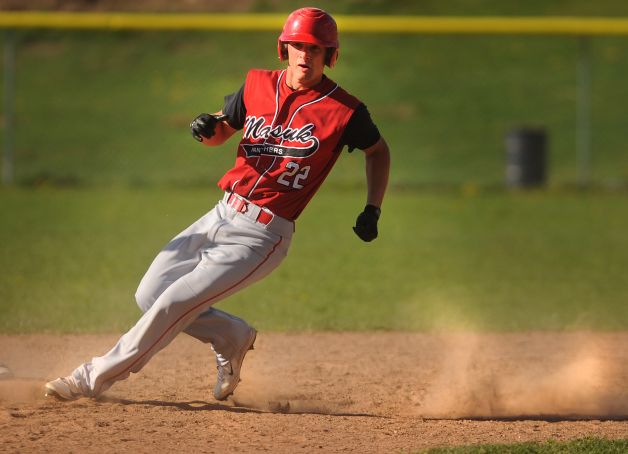For High School Stand-outs, Major League Baseball Draft Brings Tough Decision
/
When Masuk High School baseball standout Thomas Milone of Monroe was selected by the Tampa Bay Rays in the third round, 97th overall, in this week’s Major League Baseball draft, it instantly became decision time. His choice: sign with the Rays by July 12, or go to UConn, where he has signed a letter of intent.
His decision, yet to be announced, may impact UConn’s prospects to build on this year’s successful post-season, but will certainly affect the course of his own career, in baseball  and beyond.
and beyond.
For Matt Harvey, now a standout pitcher on the New York Mets, a similar dichotomy awaited him after being drafted #118 overall by the Minnesota Twins in 2007 out of Fitch High School in Groton. Harvey decided to head to college at North Carolina, went back in the baseball player draft after his junior year, and became the #7 pick overall when the NY Mets selected him. He signed with the Mets, and his career trajectory has been upward ever since.
Among the top ten picks this year, 17 year old Phil Bickford of California will be deciding whether to sign with the Toronto Blue Jays or follow through on his commitment to Cal State Fullerton to begin college and a collegiate baseball career. High school pitcher Kohl Stewart, selected at #4 by the Minnesota Twins, has said he will likely sign with the team and walk away from a football scholarship to Texas A&M. In the seventh round, Avon Old Farms student Neil Kozikowski, a pitcher from Burlington, was selected by the Pittsburgh Pirates, the 239th player selected.
For two other Connecticut players were drafted this week, it was a stellar college career that contributed to their position in the draft:
- John Murphy, a former Seymour High and Sacred Heart University shortstop, was the sixth-round selection with the 194th pick for the New York Yankees. He is the highest selection in SHU history and the 14th player from the school ever to be drafted, according to the Connecticut Post.
- University of Connecticut infielder L.J. Mazzilli, son of former major leaguer Lee Mazzilli, was drafted by the Mets in the fourth round -- 40 years after his dad was a first-round pick of the club. L.J. Mazzilli helped lead the Huskies to the Big East tournament title and an automatic berth to the NCAA tournament this year. He had been drafted by the Minnesota Twins a year ago, but opted to stay at UConn for his senior year.
Play college ball, or turn pro? For Joseph Matthews, first vice president and senior investment management consultant with the Global Wealth Management Division of Morgan Stanley Wealth Management in Fairfield, the answer is in the numbers.
Matthews, writing in the Connecticut Post, notes that Georgetown University’s Center on Education and the Workforce has found that “people who hold a bachelor's degree have an 85 percent higher lifetime earning capacity than people with only a high school education. With an undergraduate college degree, a person will average lifetime -- that is, from age 25 to 64 years -- earnings of $2.8 million. With a high school degree, that average plummets to $1.5 million.” Here’s how Matthews breaks it down:
- Right now, there are 750 players on 30 major league teams. Additionally, there are 4,000 players on 160 teams in the minors.
- Less than three in 50, or only about 5.6 percent, of high school senior boys in interscholastic baseball programs will go on to play men's baseball at an NCAA member institution.
- Of those, fewer than 11 in 100 senior players in NCAA will be drafted into professional baseball. In all, only one in 200 (about 0.5 percent) high school seniors playing interscholastic baseball will eventually be drafted by an MLB team.
By way of comparison, data indicates that in basketball .03% of high school athletes are drafted by NBA teams; in football the percentage is .09% reacingh the NFL, in hockey it is 4% who achieve the NHL level.
The economics – for those who don’t make it to the major leagues – are stark. “For the minor leagues, roughly 1,500 players are drafted per year, yet only 1,000 will actually get to play. These lower-level athletes are only paid a fraction of what their major league counterparts are paid: a first contract season pays only $850/month, maximum. Taking into account rent, food, utilities, transportation, entertainment and all the other expenses of independent living, it would be exceedingly difficult on a minor league salary to grow a nest egg for future use,” Matthews suggests.
Those whose careers don’t rise above the minors will be “cast out into the labor force, often with a wife and children, and no marketable skills to speak of,” Matthews says. He concludes that “donning a cap and gown and stepping up to a podium -- to accept a college diploma -- is a far more realistic way to achieve their dreams.”
That is an opinion that Milone, and other freshly minted high school graduates drafted by a major league franchise this week, may well be pondering.





























